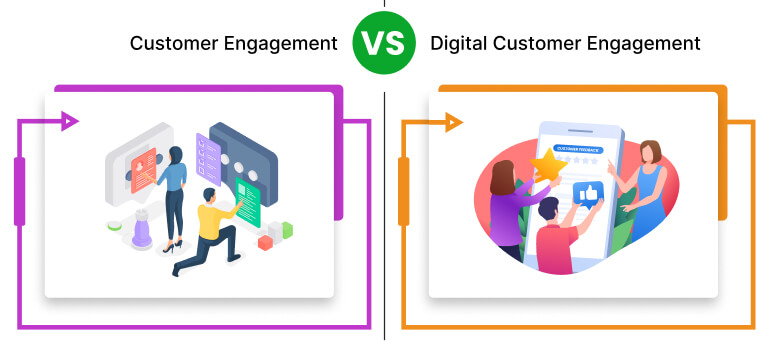 Customer Engagement
Customer Engagement

24 December, 2023

Are you getting frustrated with almost no attention and interest from the customers in your brand or products? Fret not! Digital channels are here for you to transform the game. It not only provides a better customer experience but also boosts your bottom line. But the big question remains: how does digital media increase customer engagement?
Wondering! Right? Let me explain!
Digital media opens the door to a vibrant marketplace of engagement where your brands can connect with target audiences. From personalized content to interactive experiences, it fosters two-way communication, builds trust, and drives brand loyalty.
And the secret is, various SaaS tools can be your friends here as incredibly powerful customer engagement channels!
That’s not the end here! Get ready to explore more secrets of SaaS-powered strategies to boost customer engagement and drive business growth.
Contents
Digital media engagement is a measurement of interaction on how many digital users interact with each other with various forms of digital media.
Think of it like this, you have a brand, and a wider audience is trying to engage with your content or brand. Whether it would be social media, a community forum, or via customer service bots on your website.
More clearly, digital customers always find effective ways to interact with their favorite brands or services via technology. And how they are making a strong bond refers to digital engagement.
Though it is a complex and multifaceted phenomenon, here are a few aspects to describe how audiences interact with digital media:

Customer engagement is simply like engaging audiences with a specific brand, no matter what the media is. In another case, digital customer engagement is like a subset of customer engagement that focuses on leveraging digital channels to build meaningful interactions with customers.
For example, we can talk about LEGO, the world’s largest plastic building-block toy company.
Their recent #RebuildTheWorld campaign was truly outstanding for customer engagement where they promoted creativity and imagination among individuals. With its digital customer engagement approach, it targeted its potential customers and increased the sales to the next level.
To clear the concept, have a short glimpse at the key distinctions between these two terms:
# Main Focus And Objectives
Customer engagement focuses on building relationships and emotional connections with the customers to encourage repeat purchases or for higher average order values. In another case, digital business sharpens this focus by leveraging the unique capabilities of digital channels that improve engagement.
Here the marketers use information to personalize content, recommendations, or interactions in real-time to create a more engaging experience.
# Metrics
The core metric of customer engagement is customer satisfaction with specific interactions, like a purchase or service call. The customer service statistics of the business track how many customers remain with the brand over a specific period.
Besides, the DCE is measured through website traffic, social media engagement, click-through rates, conversion rates, and so on.
# The Ultimate Goal
The goal of customer engagement is to earn brand loyalty while DCE fuels sustainable growth and customer loyalty through the power of digital channels.
As with digitalization, digital media are becoming an extensive powerful tool for digital customer engagement and retention. It offers an interactive platform that makes it easier for you to connect with audiences and create a positive brand experience.
It also helps build trust and loyalty towards the brand and make meaningful relationships.
A study shows that companies using digital customer engagement experienced a 90% increase in their revenue on average, highlighting the significant growth compared to the previous year’s 70%. source
Also, you can see the survey below:
According to a June 2022 survey, 89% of marketing leaders worldwide rely on pre-produced and live-stream video formats as customer engagement tools. source
Here are some more ways where you can define digital media as an effective process for customer engagement:
You can create informative and engaging content for your business across various platforms like blogs, social media, or videos. It will increase your brand awareness and help you attract new customers.
Digital marketing engagement is more cost-effective than traditional methods in which you can reach your content or products to a wider audience with a smaller budget.
As per DemandMetric’s study, content marketing costs 62% less on average than the other traditional methods but generates 3 times more leads. source
With digital platforms, customers can access information, support, and services anytime, anywhere. This eliminates their long waiting time and addresses their issues immediately, leading to improved satisfaction.
Digital brand engagement is a great method to build efficient and effective communication with customers for your business. Platforms like social media, live chat, and even comment sections on blog posts allow direct interaction with customers. This encourages a sense of community and lets your customers feel special.

Proper use of digital media for customer engagement is the key to building thriving online communities and boosting your business. Here are some effective strategies to look at:
Step #1: Start by creating personalized content to specific customer interests and preferences. You may assume that you may need to be present on every platform. But in reality, you only need to be where your target audience lives.
Thus, learn about your target market and use data and segmentation tools to tailor content.
Step #2: After managing content, you need to utilize the power of different platforms to reach your voice. Match your content to the strengths of each platform and leverage platform-specific ads to reach your ideal customers.
Step #3: Customer purchases from the companies that care more about customer service. Thus keep engaged with your audience. Respond promptly to their comments, messages, and reviews or you can run social media polls to gather valuable insights.
Step #4: You can follow quality customer service models or frameworks to outline how a good company interacts with and serves its customers.
Step #5: Make it easy for customers to interact with you on the go. You can offer exclusive discounts, early access to products, or loyalty programs to enhance engagement.
Step #6: As with fostering engagement, it is also crucial to monitor engagement rates, click-through rates, and conversion rates to know what’s going on.
If required, experiment with different content formats or change posting times to see what resonates best. That means you need to always keep your customers on track.
SaaS tools are a great way that facilitate user engagement and create more interaction for them to improve customer experience. Effective tools will hook users by automating repetitive tasks, promoting real-time collaboration, fostering a sense of connection, or personalizing experiences
But the truth is the market is flooded with uncountable SaaS options with different facilities. It is a daunting task for many new comes to figure out the best one of them that will meet the specific requirements of their brand or product.
Don’t fret! Let’s help you out there to make an informed decision by outlining the best SaaS tools for your business with their unique features and benefits.
If you want to help your business improve customer engagement by directly interacting with your users’ activity, Google Analytics is the go-to choice for you.
It provides clear insights into how customers interact with products or marketing campaigns. This deep analysis allows businesses to identify trends and optimize their digital engagement strategy accordingly.
Key Features & Benefits
| What’s Best | Reason To Ignore |
| Have a variety of custom graphs, charts, and reports to analyze traffic data.
Can easily integrate with Google Ads or Google Tag Manager. |
Chances of data overloads that cause analysis paralysis
Need expertise to set up event properties and parameters. Chances of data inaccuracies due to factors like ad blockers or referral spam. |
Pricing: Premium plan starts at $12,500/month. Free plan available.
Buffer is an amazing social media scheduling and analytics tool that allows businesses to plan and publish content across various social media platforms. It helps to create posts, add images, videos, GIFs, and a preview to monitor how the user looks on each platform.
Based on the reports, the business can easily streamline social media posting and maintain a custom posting schedule that not only saves time but also increases your reach and grows your brand online.
Key Features & Benefits
.
| What’s Best | Reason To Ignore |
| Flexible pricing model
In-depth social analytics and reports Simple UI/UX interface Easy to use |
Need to supplement with other tools
Very basic Instagram and Pinterest features. |
Pricing: Free trial options are available while the premium plans start at only $15/month.
Sprout Social is a social media management and analytics tool that provides features for content scheduling, engagement monitoring, and social listening. It helps to create and schedule posts on Facebook, Twitter, and many more.
So what’s the difference from Buffer? In Sprout, you are getting some special API settings on the Chatbot in customer service to engage the audience. Moreover, you will find an analytics feature to immediately spot trends and potential customers.
And to make more and more customers, social CRM and advocacy tools will play a big role on the platform.
Key Features & Benefits
| What’s Best | Reason To Ignore |
| User-friendly
Robust analytics and reporting Schedule and publish content |
A bit expensive
No free plan is available |
Pricing: Offers plans in various segments where the basic plan starts at $249 per month and $199 per month for each additional user.
Pendo is a platform that is specifically designed to enhance and optimize user engagement.
It is highly known for its product analytics, user feedback capabilities, and specialized tools to help understand how users interact with the brand. It also offers an onboarding process to get through the features and functionalities of a product and allows businesses to improve accordingly.
Plus with the in-app messaging, users can directly communicate and take guidelines toward specific actions. This allows you to interact with more and more customers with your brand. All in all, it is a bit expensive, the best customer service platform to engage users.
Key Features & Benefits
| What’s Best | Reasons To Ignore |
| A unique product experience platform to analyze products.
Multiple integrations Easy to use Comprehensive feedback management system |
Requires high technical knowledge to understand some of the customized features. |
Pricing: The free version is available while The Starter plan starts at $7,000 per year for premium users.
Mixpanel is the most popular platform in the customer service industry, acknowledged with all the advanced features to deep insight the customer behavior and overall journey.
It is a robust analytics and engagement platform that businesses often choose to enhance customer engagement.
First of all, the event tracking tool allows businesses to monitor and analyze specific user interactions with digital products and how they engage with various features. Even using the funnel, you can easily identify the drop-off point and customize your journey, ultimately improving engagement and conversion rates.
Key Features & Benefits
| What’s Best | Reason To Avoid |
| Insight Report
User-friendly interface Event-based data model |
Expensive
Need to concentrate more on how to improve customer service skills |
Pricing: Mixpanel has freemium plans, offering essential features that you can upgrade with the Growth plan, which starts at only $20/month.
Yes, interactive content like quizzes and polls increases customer engagement and retention rates. It gathers valuable data about your audience’s preferences from which you can optimize content to better meet their needs.
Personalized email marketing campaigns are an amazing way to engage customers by creating more relevant messages. Personalized subject lines and content are more likely to grab attention and encourage to open the email and start conversions.
Live broadcasts create a sense of immediacy and allow two-way communication where customers ask questions and offer feedback. This direct interaction encourages a sense of connection between the brand and customers.
Well, that is all how digital media increases customer engagement. If you are feeling like your brand is stuck in a dark hole, approaching digital media is the right platform to step in.
It offers uncountable benefits that contribute to business success. From real-time interaction to enabling instant communication, tailoring content based on customer preferences, or providing valuable data on customer behavior, the digital channel is enough to transform your barren business into a customer flock.
Give it a try!